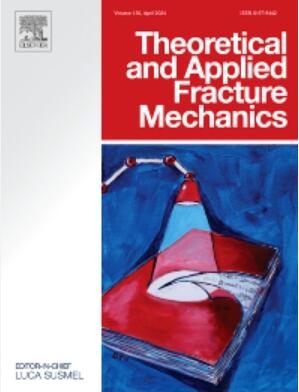IF 5
2区 工程技术
Q1 ENGINEERING, MECHANICAL
引用次数: 0
摘要
在地下工程中,动态扰动和结构平面(不连续面)对围岩破坏的影响至关重要。为了探索动态扰动下结构平面的岩爆过程,我们进行了真正的三轴试验,在试验中考虑了结构平面和周期性弱扰动的动静耦合加载。试验对象是带有圆孔和预制裂缝的立方体试样,模拟结构平面。在三种不同的扰动频率和振幅条件下(条件 1:2 Hz,40 KN;条件 2:6 Hz,30 KN;条件 3:10 Hz,15 KN),通过高速摄像系统和声发射系统对围岩的破坏和微裂缝过程进行了监测。在三种弱动态循环扰动条件下,对有结构平面和无结构平面试样的破坏过程、强度特征、声发射特征、碎片分形特征和破坏形态进行了对比分析。主要结论有:(1) 在均匀加载阶段,不连续性改变了岩爆的发生时间、位置和强度。(2) 结构平面和扰动都会在一定程度上削弱岩体。不同的扰动条件对结构控制岩爆有不同的影响。扰动振幅的增加会促进岩体产生新的破坏,而扰动频率的增加则会促进原有微裂缝的扩展和连接。在有结构平面的试样中观察到更多的剪切裂缝。扰动加剧了应力集中,导致岩体遭受更严重的破坏。在实际工程中,施工应尽量避免不连续性。灌浆和支撑可以有效减少结构平面造成的岩爆危害。本文章由计算机程序翻译,如有差异,请以英文原文为准。
Experimental study on the influence of structure plane on rockburst of hard rock tunnel under combined dynamic-static loading conditions
Dynamic disturbances and structural planes (discontinuities) are of critical importance in influencing the damage of surrounding rock in underground engineering. To explore the rockburst process of structural planes under dynamic disturbances, true triaxial tests with coupled dynamic − static loading considering structural planes and periodic weak disturbances were carried out. Cubic specimens with circular holes and pre − fabricated cracks, simulating structural planes, were used as test objects. The damage and micro − cracking processes of the surrounding rock were monitored by a high − speed camera system and an acoustic emission system under three different disturbance frequency and amplitude conditions (Condition 1: 2 Hz, 40 KN; Condition 2: 6 Hz, 30 KN; Condition 3: 10 Hz, 15 KN). A comparative analysis was conducted on the failure processes, strength characteristics, acoustic emission features, debris fractal characteristics, and damage morphologies of specimens with and without structural planes under the three weak dynamic cyclic disturbance conditions. The main conclusions are (1) During the uniform loading stage, discontinuities change the occurrence time, location, and intensity of rockburst. During the disturbance, the damage of specimens with structural planes mainly occurs on the side without structural planes, and the damage intensity and frequency are lower than those of specimens without structural planes.(2) Both structural planes and disturbances weaken rock masses to some extent. Different disturbance conditions have different impacts on structure − controlled rockbursts. An increase in disturbance amplitude promotes new failures in rock masses, while an increase in disturbance frequency facilitates the expansion and connection of original micro − cracks.(3) The presence of structural planes changes the damage pattern of specimens. More shear cracks are observed in specimens with structural planes. The disturbance exacerbates stress concentration, leading to more severe damage to the rock mass. In practical engineering, construction should avoid discontinuities as much as possible. Grouting and support can effectively reduce the hazards of rockbursts caused by structural planes.
求助全文
通过发布文献求助,成功后即可免费获取论文全文。
去求助
来源期刊

Theoretical and Applied Fracture Mechanics
工程技术-工程:机械
CiteScore
8.40
自引率
18.90%
发文量
435
审稿时长
37 days
期刊介绍:
Theoretical and Applied Fracture Mechanics'' aims & scopes have been re-designed to cover both the theoretical, applied, and numerical aspects associated with those cracking related phenomena taking place, at a micro-, meso-, and macroscopic level, in materials/components/structures of any kind.
The journal aims to cover the cracking/mechanical behaviour of materials/components/structures in those situations involving both time-independent and time-dependent system of external forces/moments (such as, for instance, quasi-static, impulsive, impact, blasting, creep, contact, and fatigue loading). Since, under the above circumstances, the mechanical behaviour of cracked materials/components/structures is also affected by the environmental conditions, the journal would consider also those theoretical/experimental research works investigating the effect of external variables such as, for instance, the effect of corrosive environments as well as of high/low-temperature.
 求助内容:
求助内容: 应助结果提醒方式:
应助结果提醒方式:


